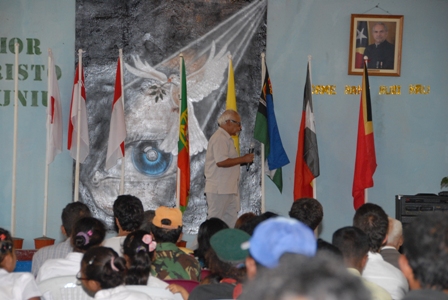Timor-Leste: Making peace not on one day but everyday

Last week Timor-Leste’s newest ‘Peace House’ was already packed out. More than 500 people came to be part of the inauguration ceremony of the Baucau ‘Peace House’.
The building stands proud in the centre of Baucau, a city which has been badly damaged during the outbreaks of violence that swept the country after independence. Even six years ago, it would have been difficult to believe the day’s event could be possible. But the Baucau ‘Peace House’ is laying the foundation for not simply making peace on one day, but on everyday.
The new and the old unite
President Ramos-Horta unveiled the plaque as part of ceremony where ‘tradition’ and ‘modernity’ united. Symbolism provided the focus of the event as older generations participated side by side, with younger Timorese. One of the world’s newest countries, Timor-Leste has one of the youngest populations.
Answering the request of Timorese
Over 900 Timorese, had taken part in a nationwide dialogue on the obstacles that stand in the way of peace. Participants, from all levels and sectors of society, felt that ‘Peace Houses’ would make a significant difference. They would provide a space for residents to meet peacefully and resolve differences and find solutions. They felt any new Peace house should be based on the tradition of Fatin Nahe-biti, or mat meeting place. It would lay the foundations for lasting peace within and between communities.
“The creation of these ‘Peace Houses’ provides an alternative channel for conflict resolution. It enables the Timorese people to seek a peaceful solution to conflict. The ‘Peace Houses’ will provide a location where participants feel secure and are able to speak openly and honestly about their grievances and collectively identify solutions.” says Renée Larivière, Interpeace Director of Programme Development. She adds, “The turn out today and the enthusiasm that surrounds the ‘Peace House’ project is evidence of how the international community can help empower the local people so that they can craft solutions that work for them.”
Prominent figures attended the event
President Ramos-Horta was joined by local traditional and administrative leaders, as well as representatives from Interpeace, its local partner the Centre of Studies for Peace and Development (CEPAD), the Global Development Group (GDG) and The Charitable Foundation.
More ‘Peace Houses’ to come
The ceremony in Baucau on September 14, 2011 marked the second Peace House constructed this year. The first was in Aileu and inaugurated by the local community on August 5, 2011. As part of the ongoing project two additional “Peace Houses” will be built, in the districts of Maliana and Ainaro. Together the four houses will serve as the pilot for the programme.
Partners making the ‘Peace Houses’ possible
Peace Houses are part of a strategic initiative to enable Timorese to build lasting peace. The ‘Peace House’ pilot project is being funded by The Charitable Foundation, an Australian based organization that complements and sustains the dialogue activities undertaken by Interpeace local partner, CEPAD.
"This initiative is just one part of the work being carried out by the CEPAD team as they work to highlight and address the root causes of conflict and the obstacles that stand in the way of lasting peace,” says Renée Larivière.
